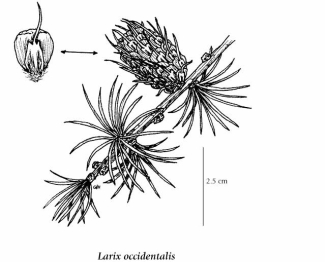western larch
Pinaceae (Pine family)
Introduction to Vascular Plants
Introduction
The western larch is unusual in that it is a deciduous coniferous tree that loses its needles in the winter.
|
Species Information
General:
Large tree, up to 55 (rarely 70-80) m tall; bark thick, furrowed into large plates, scales cinnamon colored; young twigs glabrous to hairy, not woolly-hairy.
Leaves:
Needles deciduous; pale green (yellow in the autumn); stiff; 15-30 per spur; 25-45 mm long; broadly triangular in cross-section.
Cones:
Seed cones 25-30 (35) mm long, yellowish-brown; pollen cones yellow, about 10 mm long.
Illustration

If more than one illustration is available for a species (e.g., separate illustrations were provided for two subspecies) then links to the separate images will be provided below. Note that individual subspecies or varietal illustrations are not always available.
Illustration Source: The Illustrated Flora of British Columbia
USDA Species Characteristics
Flower Colour:
Red
Blooming Period:
Spring
Fruit/Seed characteristics:
Colour: Brown
Present from Summer to Fall
Source: The USDA
Ecology
The table below shows the species-specific information calculated from
original data (BEC database) provided by the BC Ministry of Forests and Range.
(Updated August, 2013)
| Site Information |
Value / Class |
||
|
Avg |
Min |
Max |
|
| Elevation
(metres) |
1121 | 110 | 2635 |
| Slope
Gradient (%) |
28 | 0 | 235 |
|
Aspect (degrees) |
325 | 0 | 360 |
| Soil
Moisture Regime (SMR) [0 - very xeric; 4 - mesic; 8 - hydric] |
3 | 0 | 7 |
| Modal
Nutrient Regime
Class |
C | ||
| #
of field plots species was recorded in: |
1955 | ||
| Modal
BEC Zone Class |
ICH | ||
|
All BEC Zones (# of stations/zone) species was recorded in |
AT(2), ESSF(166), ICH(1026), IDF(379), MS(283), PP(16) | ||
|
Source:
Klinkenberg 2013
|
|||
Habitat and Range
Moist to dry slopes in the montane zone; common in SC and SE BC; E to SW AB, and S to OR, NW MT, and N ID.Status Information
Taxonomic Keys
1. Seed cones about 1-2 cm long; bracts shorter than scales; needles 1-2.5 cm long, triangular in cross-section.....................Larix laricina
1. Seed cones usually over 2.5 cm long, bracts longer than scales; needles 3-4 cm long. 2. Needles 4-angled in cross-section; young twigs strongly woolly-hairy; cones usually over 3.5 cm long; trees usually at or near timberline..........................Larix lyalli 2. Needles flattened or triangulur in cross-section; young twigs glabrous to somewhat hairy; cones rarely as much as 3.5 cm long; trees of montane forests...................Larix occidentalis Source: The Illustrated Flora of British Columbia. |